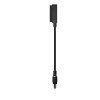maxpower
Well-Known Member
Hi there,
since my first Mavic Pro i always wanted to have a more flexible way of charging the drone batteries on the go. Unfortunately, only car chargers were available, nothing via USB.
I think DJI missed out on a big feature for the mavic air2 by not implementing USB-PD charging.
Finally i got my act together and developed a power delivery system for that.
It is more or less a small cable where you can plug in your drone battery, on the other end are some ICs, Chips, and so on. But pretty small and very light. There is also a USB-C Connector.
So basically it works like this: you have your typical wall charger (for your smartphone, macbook, etc.) or any other type of charger that has a USB-Port.
From there you plug the cable into my dev-charging-cable and it will output the correct voltage to charge the drone battery.
Of course, this can be done quite easily, with some simple step-up converters but using the old-school method would mean: USB-Charging with 5-Volts and maximum of 2 Amps, so well, it would take forever to charge one battery.
This is where the USB-Power-Delivery (USB-PD) Standard comes into play: within my dev-charging-cable is also a small circuit to negotiate the USB-PD Voltage.
Modern chargers (like Smartphone Chargers) can supply alot more than 5 Volts, going up to 20 Volts and also high Amps, so the charging Watt is very high.
For example, there are some wall chargers from apple supply 87 Watts via USB-C! The official DJI Charger for the Mavic Air2 only outputs around 38 Watts. So that's more than enough power.
My circuit is designed, so it tries to negotiate a very high output power from the carger and converts that into the exact same voltage, the original charger uses. Even the Amps are capped, so i won't apply to much power to the battery.
What's the benefit?
I only need to carry around one simple cable. I can charge my mavic air2 battery wherever i want, as everybody has some usb-charger in the car nowadays or a friend nearby or whatever.
If the charger supports USB-PD (which almost every smartphone charger does), the battery can be charged rather quickly - and in the unfortunate event of a charger, that does not support USB-PD, i can still charge my drone (even at McDonalds there are USB-Ports in the tables ...), but it will take longer.
I am currently redesigning the layout of the PCBs and shrinking everything down a little more, then i will post some pics here.
I mainly did this for myself, but i am wondering if i can make a product out of this?
I did not find anything like this anywhere, so what do you guys think?
Would you need one of those? Would you buy one?
Of couse this method can be used for any drone battery, even the ones from the mavic pro 2 with 4S Lipos.
Thanks in advance for your response!
I think you have a great idea. I would like to charge my drone batteries using USB power banks when off the grid. I have 2 iMuto power banks 27000 and 30000 mAh that deliver 5V/2A. For me charging overnight is perfectly fine, I’m not concerned about speed. Since this would replace the need for the official DJI car charger because I could now use the 12V to USB car adapter, I’d gladly pay you upwards of $60 even $70 USD as long as it robust and reliable.
A suggestion if you are really serious about it, would be to incorporate a quick connector so it could be used for other drones that use the same/similar charging voltage (around 13V???). So it’s USB-to-your circuit-to-quick connector and the you have various adapters, quick connector-to-MA2 battery plug, quick connector-to-M2 battery plug, quick connector-to-MP battery plug, etc.
Put me down for one.
















